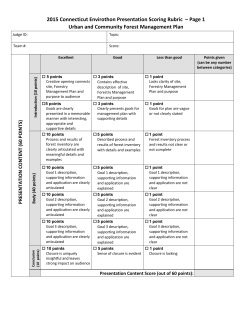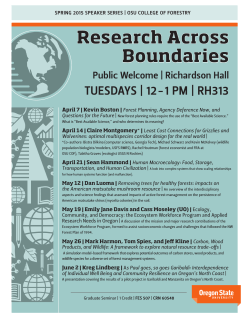
introductory slideshow
Oregon Envirothon Environmental Education Competition Promoting Conservation Education of our Natural Resources What is Oregon Envirothon? Envirothon is an annual competition in which teams compete for recognition and awards by demonstrating their knowledge of environmental science and natural resource management. What is Oregon Envirothon? The teams, each consisting of five high schoolaged students, exercise their training and problem-solving skills in a competition centered on four universal testing categories (soils/land use, aquatic ecology, forestry, and wildlife ecology) and a current environmental issue. Mission of Oregon Envirothon Envirothon succeeds in its mission to develop knowledgeable, skilled, and dedicated citizens who are willing and prepared to work towards achieving a balance between the quality of life and the quality of the environment. Mission of Oregon Envirothon Serves as the Oregon State FFA competition for Environmental Science. One third of teams competing are FFA affiliates Benefits to participating in Oregon Envirothon Students gain environmental literacy through: In-class curriculum Hands-on field trips Benefits to participating in Oregon Envirothon Students learn: Decision-making skills Problem-solving skills Cooperative-learning skills All revolving around real life issues such as these past Current Environmental Issue Topics: Acid Rain Farmland Preservation Pest Management Nonpoint Source Pollution Benefits to participating in Oregon Envirothon The winning team has the opportunity to attend the North American Envirothon and compete for $107,000 in scholarships! History of Oregon Envirothon Started in 1997 through the Marion SWCD The Marion SWCD and the Oregon Forest Resources Institute are the primary sponsors for this event There is only one statewide competition per year (there are no regional events) Oregon Envirothon Overview Study throughout the school year Five written test sites Oral Presentations T-shirts Awards for 1st – 5th Focus Subjects Forest Ecology Soils/Land Use Wildlife Ecology Aquatic Ecology Current Environmental Issue – – – – – – Recreational Impacts on Natural Resources (2008) Biodiversity in a Changing World (2009) Groundwater and Land Use Planning (2010) Salt and Fresh Water Estuaries (2011) Non-point Source Pollution and Low Impact Development (2012) Sustainable Rangeland Management (2013) Annual Teacher/Advisor In-service Training Teachers and advisors learn about Oregon Envirothon’s Current Issue and can practice their hands-on skills Written Tests Test writers are solicited from the specific disciplines Tests incorporate a large proportion of hands-on questions involving – – – – Water quality testing Forest measurements Soil profiling Identification of wildlife hides, bones and skulls Forest Ecology Testing Station Sponsored by Oregon Forest Resources Institute Forest measurements – – – – Age Diameter Height Board feet Study tree rings and core samples Forest Ecology Testing Station Forest Tree ID with leaves, branches, bark, and cones Soil/Land Use Testing Station Sponsored by Benton Soil and Water Conservation District Soil Composition Soil Moisture Erosion Nutrients Soil/Land Use Testing Station Testing Soil Composition by Feel Practice your soil ribbons Soil/Land Use Testing Station Ya Gotta Dig it Wildlife Ecology Testing Station Sponsored by Salem Bureau of Land Management Animal Adaptations Invasive Species Wildlife Ecology Testing Station Wildlife Identification – Pelts – Skulls -Tracks - Scat Aquatic Ecology Testing Station Sponsored by City of Salem & Marion SWCD Water Quality testing – – – – pH Dissolved Oxygen Temperature Nutrients (Nitrate & Phosphate) Watershed Ecology Aquatic Ecology Testing Station Macroinvertebrate ID – Identification – Pollution Tolerance “Hilsenhof Biotic Index” 2015 Oregon Envirothon Current Environmental Issue “Urban and Community Forestry” Current Issue Testing Station 2015 Oregon Envirothon Current Issue “Urban and Community Forestry” Urban and Community Forestry can be defined as the planting and care of amenity, or landscape trees, collectively, in human settlements. Urban and community forests broadly include urban parks, street trees, landscaped boulevards, public gardens, river and coastal promenades, greenways, river corridors, wetlands, nature preserves, natural areas, shelter belts of trees and working trees at industrial brownfield sites. Current Issue Testing Station 2015 Oregon Envirothon Current Issue “Urban and Community Forestry” Key Topics 1. Understand what sustainable urban & community forestry is and why it is important. 2. Understanding of the numerous benefits of urban/community forests to society, often referred to as ecosystem services. 3. Understand the costs associated with urban/community forests. 4. Understand what an urban forest management plan is and why it is an essential tool. Current Issue Testing Station 2015 Oregon Envirothon Current Issue “Urban and Community Forestry” Learning Objectives 1. Describe the economic, social, and environmental benefits of urban/community trees to local communities. 2. Comprehension of the effects of urban/community trees on air quality and water quality. 3. Knowledge of research showing that trees contribute to our health, well-being and quality of life. 4. Understanding of threats to urban/community forests such as invasive species, insect and diseases, climate change, fire, air pollution, lack of management capability and development pressures. 5. Understand what a tree inventory is and what it is used for. 6. Understand the components of an urban/community forest management plan. 7. Basic knowledge of models and tools used to calculate the value of tree canopy functions. “Urban and Community Forestry” Oral Presentation Problem Urban and Community Forest Management Planning An urban forest management plan is a road map, providing detailed information, recommendations and resources needed to effectively and pro-actively manage and grow a city’s tree canopy. More importantly, it provides a shared vision for the future of the urban forest to inspire and engage stakeholders in the care and protection of trees. Your goal is to work together as an interdisciplinary team to conduct a forest inventory and create an urban/community forest plan for an area near you. This area can be a neighbourhood, park, open space, new development or your school grounds. We recommend that you review the “eLEARN - Urban Forestry” program at: http://urban.elearn.sref.info for background information. When doing your forest inventory, you may use the information on the “Urban Forest Management Toolkit” at: http://ufmptoolkit.com as a guide. There are other resources, web links and sample plans on the accompanying Oregon Envirothon Resources 2015 DVD that may be of assistance to your planning team. “Urban and Community Forestry” Oral Presentation Problem Be sure to include the following points in your plan. History and details of your urban forest: location, size, demographics, amenities, present resource use Results of your urban forest inventory: what is presently on the ground and are there any issues needing immediate attention Develop your management plan: what maintenance is needed, are more trees going to be planted and if so, what species, how many and where Create a map of present and proposed site conditions “Urban and Community Forestry” Oral Presentation Problem Is there site preparation needed before planting What are the costs associated with implementing and maintaining your plan What are the present and proposed social and economic benefits to your plan (http://www.treebenefits.com/calculator/index.cfm) What are the benefits to the natural and human environments of your management plan What are the political issues regarding your management plan What types of maintenance and monitoring do you foresee for your urban forest How will your plan be sustainable and will it adequately protect and improve the land, air and water resources “Urban and Community Forestry” Oral Presentation Problem You may be as original as you wish as long as you can document that your actions will be successful, sustainable and manageable. You may refer to development designs, case studies and implementation strategies that have been used successfully across the Pacific Northwest. Be sure to properly cite all references referred to in your presentation. Your presentation must be 10 minutes in length and all team members must participate. You are not required to use computer technology (i.e. PowerPoint) for your presentation but it is acceptable. You may use flip charts, props, or a combination. Judges scoring is based on content, not the method of delivery. Record a video of your presentation and submit it to Oregon Envirothon by the due date of April 15, 2015. Written Tests Plants living in hydric soils may have which of the following adaptations: a. hollow stems b. waxy roots c. high transpiration rates d. high photosynthetic rates Written Tests Identify the points on the tree cross section using either the sample on the table or the diagram below. Write in the correct name of the part and its function. 1. Outer Bark 2. Phloem 3. Cambium 4. Sapwood/Xylem 5. Heartwood Written Tests The process of eluviation moves soil particles downward in the soil as a result of rainfall infiltration. The particles that move downward are: A. B. C. D. Sand particles Clay particles Grit particles Organic matter particles Oral Presentation Problem The current issue topic is narrowed down to a specific problem relative to Oregon and: All teams send in a 10-minute video presentation on the problem to be judged prior to the event The top 3 teams give a live 10-minute presentation at the competition North American Envirothon The Envirothon is North America’s largest high school environmental education competition, reaching more than 500,000 students across North America annually. Canon Envirothon Host Sites Rotate Annually around North America 2008 - Flagstaff, Arizona 2009 - Ashville, North Carolina 2010 - Fresno, California 2011 - Sackville, New Brunswick 2012 – Selinsgrove, Pennsylvania (25th Anniversary) 2013 – Bozeman, Montana 2015 – Springfield, Missouri 2008 Oregon Envirothon Newberg High School won the Oregon Envirothon and went to the North American competition in Flagstaff Arizona. Training in Sedona Arizona Two days of intense, hands-on training proceeded the competition Studying Southwest Ecotones Colorado Plateau Desert Transition Zone Pinyon/Juniper Forest Ponderosa Pine Forest Northern Arizona University Oregon Envirothon T-Shirts are a hot trade item Grand Canyon Tour A Combination of Fun and Learning North American Envirothon Newberg scored 13th place out of 54 teams & 1st Place in Soils and Land Use! North American Envirothon 2009 South Salem High School University of North Carolina – Ashland Placed 26th North American Envirothon 2010 Newberg High School California State University – Fresno Placed 17th North American Envirothon 2011 South Salem High School Mount Allison University – New Brunswick, Canada Placed 23rd North American Envirothon 2012 Newberg High School Susquehanna University - Selinsgrove, Pennsylvania Placed 26th North American Envirothon 2013 Newberg High School Montana State University, Bozeman Placed 34th How do schools participate in Oregon Envirothon? Teacher or advisor recruits students – Ron Crouse is available for presentations Teacher or advisor attends the in-service – Funding is available for substitute teachers Teacher or advisor begins training students and scheduling field trips and training sessions How do schools participate in Oregon Envirothon? Teacher or advisor turns in registration and paperwork to Ron Crouse Team turns in a video of their oral presentation in mid-April Team attends the competition in May at the Oregon Garden – Reimbursement for travel costs are available Oregon Envirothon Traveling Trunk Program Six trunks of equipment are available for teams to use for training for the hands-on portions of the competition. The Best Thing about Oregon Envirothon It is FUN!
© Copyright 2025









